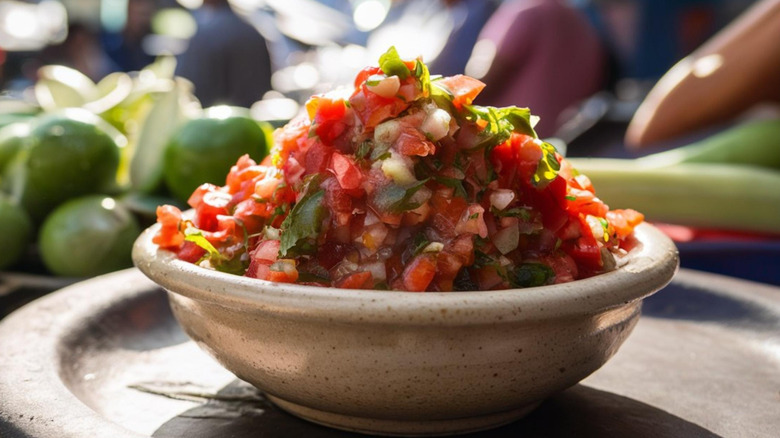The Best Tomatoes For Every Kind Of Homemade Salsa
Few condiments pack the vibrancy of salsa. Simply the Spanish word for sauce, this essential Mexican side uses a foundation of tomatoes, peppers, and onions to craft a dizzying variety of mouthwatering creations. And since mastering the aromatic qualities of each component can lead to a more flavorful salsa, it's a food that rewards a careful look at its details.
For every kind of homemade salsa, you'll want to consider the tomato variety. Thankfully, Chowhound has exclusive advice from Antonio Nuño, Executive Chef of Grand Hyatt Playa del Carmen, who shares his go-to tips and tricks for which tomato varieties make crafting homemade salsa a breeze.
To start, he urges considering whether the salsa will be raw or cooked. For the former, he uses less ripe and more firm varieties which offer a pleasant tang and texture. But if you're cooking salsa, it's time to reach for a sweeter, riper fruit variety. Throw in the option of green tomatoes and tomatillos, and the salsa possibilities just keep growing.
Use firm tomatoes for a pico de gallo
Pico de gallo is different from salsa because of its chunky consistency. The condiment combines a delicious mix of diced onions, cilantro, and tomatoes, all diced up and tossed with lime juice. Classified as a salsa cruda, this style lets the ingredients shine in their raw state. As a result, you'll want to pay special attention to the best tomato variety. The fruit serves as an integral element in the dish, lending its signature consistency.
To satisfy such requirements, chef Antonio Nuño recommends reaching for saladette or guaje tomatoes. Similar to Roma tomatoes in the U.S., this variety possesses less juice, instead offering a fleshier consistency. Nuño notes, "Their firmness at maturity ensures the sauce maintains its texture and freshness while prolonging its shelf life." These two tomato varieties offer the appearance and flavor necessary for pico de gallo. Nuño also praises their "bright red color, and a good balance of acidity." When crafting a five-ingredient pico de gallo, the right tomato type makes all the difference.
Try plum tomatoes and tomatillos for blended salsas
Blended salsa reveals its preparation in the name. Aromatic ingredients go into the blender to be pulsed into a homogeneous mixture. Consequently, the tomato's flavor — not its texture — becomes a greater focus. Antonio Nuño states that the saladette tomato variety functions well for this task, with its meatier consistency imparting a saturated flavor. The chef also cites that the tomatoes you might use for juicing will also produce a well-blended salsa.
A common name for the saladette tomato, plum tomatoes — like the famous canned San Marzanos — are frequently used in processed foods including pastes, sauces, and salsas. Nuño also recommends tomatillos for blended salsas. Although not a tomato plant, this similar fruit brings vibrance to an eye-catching green salsa. For maximum flavor, Nuño even advocates for blending the two varieties together, explaining, "Combining them can also create a more complex flavor profile."
Roasted salsas highlight many tomato varieties
If you're keen on crafting a salsa with an intensified flavor, then first roasting the ingredients is a savvy move. According to Antonio Nuño, a little heat will caramelize the tomatoes, bringing out their sweet flavors and adding a rich, smoky flavor. It's a preparation that'll work well with many tomato types, so you can tailor the variety to your taste.
For the most sweetness, cherry tomatoes often contain the highest sugar content and will thereby inspire rich caramelization. But if you're after something more savory — with accentuated umami flavors by way of roasting — then look for purple and black tomato varieties. Nuño also suggests green tomatoes as a great fit for roasted salsas. Their bright and acidic profile mellows out after heating, but still adds a vibrant touch. In a similar vein, don't neglect a classic roasted tomatillo salsa, which balances tangy and sweet notes in captivating fashion.
Pair tomatoes with chiles in a hot salsa
When making a pepper-forward salsa, Antonio Nuño suggests selecting the tomato type based on the chiles in the mix. He looks for complementary flavors from sweet, tart, and fruity ingredients. For instance, the vibrant and vegetal serrano pepper, or the fruity, sweet, and spicy habanero both do well with raw tomatoes which are picked on the firmer side, like a green tomato or tomatillo. The acidity of green tomatoes also pairs with peppers that are especially spicy, like in the case of chile de árbol or puya chiles.
On the other hand, Nuño points out that the sweetness of chipotle, morita, or guajillo chiles pairs well with sweet and rich tomato types. He suggests the same varieties he'd use in pico de gallo: saladette or guaje tomatoes. Especially when heated, this variety of the fruit blends with the chilies in delectable ways. And, don't forget, letting your salsa rest for roughly 20 minutes in the fridge can make your salsa even tastier.




